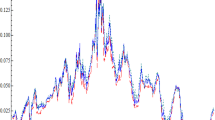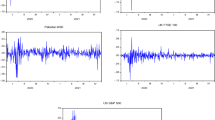Abstract
Both the goods market hypothesis and the portfolio balance theory, suggest a nexus between exchange rates and stock prices, albeit with a different direction of causality. This paper, using daily data, takes up the issue of the linkages between stock prices and exchange rates in the case of the euro-dollar rate and two composite European stock market indices: the FTSE Eurotop 300 and FTSE eTX All-Share Index. It addresses the causal ordering issue between the two markets using rolling unit root, cointegration and Granger causality tests. This methodological approach allows for the emergence of a clearer picture of the possible dynamic linkages between exchange rates and stock prices. The empirical results provide evidence of time-varying causality between the two markets.






Similar content being viewed by others
Notes
Should there be some common factors affecting both stock prices and exchange rates (e.g., interest rates) then one might expect a link between the two variables. See for example Ajayi and Mougoué (1996).
Although these methodologies have been extensively used in the relevant empirical literature, they are usually applied to full sample periods, thereby assuming that the relationship between the two markets is time-invariant. Rolling analysis is more appealing as it explicitly accounts for (more than one) changes in the underlying dependence and traces a possibly evolving system in the sense of time-varying parameters.
Rolling causality analysis is also more appropriate than the alternative recursive analysis with a growing window of data for two reasons. First, by adding observations recursively into the estimation process, one cannot differentiate whether the varying test statistics are due to a change in the extent and/or direction of causality, or to an increase in the power of tests arising from the additional observations. Second, in the case of structural breaks, recursive analysis suffers from the same drawbacks described in the main text.
Rolling ADF tests for the level and first differences of spr and DJ show that both variables are I(1). In order to ensure stationarity, both control variables appear in first difference form in Eqs. 6 and 7. Equations 6 and 7 were also estimated with one control variable at a time (spr or DJ) but the plots of the rolling F-statistics remain qualitatively the same. All results are available from the authors upon request.
Alternatively, one may use Euromarket rates. However, since both the U.S. and European markets are considered completely open, use of these rates is expected to yield the same results as using the onshore counterpart.
References
Ajayi RA, Mougoué M (1996) On the dynamic relation between stock prices and exchange rates. J Financ Res 19:193–207
Arshanapalli B, Doukas J, Lang L (1995) Pre- and post-October 1987 stock market linkages between U.S. and Asian markets. Pac—Basin Financ J 3:57–73
Bahmani-Oskooee M, Sohrabian A (1992) Stock prices and the effective exchange rate of the dollar. Appl Econ 24:459–464
Bhandari JS, Genberg H (1989) Exchange rate movements and international independence of stock markets. International Monetary Fund Working Paper WP/89/44
Caporale G, Pittis N (1997) Causality and forecasting in incomplete systems. J Forecast 16:425–437
Davidson R, MacKinnon JG (1993) Estimation and inference in econometrics. Oxford University Press, New York
Dornbusch R, Fischer S (1980) Exchange rates and current account. Am Econ Rev 70:960–971
Frankel JA (1983) Monetary and portfolio balance models of exchange rate determination. In: Bhandari JS, Putnam BH, Levin JH (eds) Economic interdependence and flexible exchange rates. MIT, Cambridge, pp 84–115
Frenkel J (1976) A monetary approach to the exchange rate: doctrinal aspects and empirical evidence. Scand J Econ 78:200–224
Gavin M (1989) The stock market and exchange rate dynamics. J Int Money Financ 8:181–200
Grambovas CA (2003) Exchange rate volatility and equity markets: evidence from the Czech Republic, Greece and Hungary. East Europ Econ 41:24–48
Granger CWJ (1969) Investigating causal relations by econometrics models and cross spectral methods. Econometrica 37:424–438
Granger CWJ, Huang B-N, Yang CW (2000) A bivariate causality between stock prices and exchange rates: evidence from recent Asian flu. Q Rev Econ Finance 40:543–575
Harmantzis F, Miao L (2009) Dynamic asymmetric dependencies between equities and exchange rate markets. http://ssrn.com/abstract=1339325. Accessed 9 January 2010
Hatemi-J A, Irandoust M (2002) On the causality between exchange rates and stock prices: a note. Bull Econ Res 54:197–203
MacKinnon JG (1991) Critical values for cointegration tests. In: Engle RF, Granger CWJ (eds) Long-run economic relationships: readings in cointegration. Oxford University Press, New York, pp 267–276
McCauley RN, McGuire P (2009) Dollar appreciation in 2008: safe haven, carry trades, dollar shortage and overhedging. BIS Q Rev 85–93, December
Morales L (2009) The dynamic relationship between stock prices and exchange rates: evidence from four transition economies. http://arrow.dit.ie/cgi/viewcontent.cgi?article=1007&context=buschaccon. Accessed 9 January 2010
Nieh CC, Lee CF (2001) Dynamic relationship between stock prices and exchange rates for G-7 countries. Q Rev Econ Finance 41:477–490
Pan M-S, Chi-Wing Fok R, Liu AY (2007) Dynamic linkages between exchange rates and stock prices: evidence from East Asian markets. Int Rev Econ Finance 16:503–520
Phylaktis K, Ravazzolo F (2005) Stock prices and exchange rate dynamics. J Int Money Financ 24:1031–1053
Sarantis N (2006) Testing for uncovered interest parity using traded volatility, a time-varying risk premium and heterogeneous expectations. J Int Money Financ 25:1168–1186
Smyth R, Nandha M (2003) Bivariate causality between exchange rates and stock prices in South Asia. Appl Econ Lett 10:699–704
Tastan H (2006) Estimating time-varying conditional correlations between stock and foreign exchange markets. Physica A 360:445–458
Wu Y (2000) Stock prices and exchange rates in a VEC model. The case of Singapore in the 1990s. J Econ Finance 24:260–274
Author information
Authors and Affiliations
Corresponding author
Rights and permissions
About this article
Cite this article
Kollias, C., Mylonidis, N. & Paleologou, SM. The nexus between exchange rates and stock markets: evidence from the euro-dollar rate and composite European stock indices using rolling analysis. J Econ Finan 36, 136–147 (2012). https://doi.org/10.1007/s12197-010-9129-8
Published:
Issue Date:
DOI: https://doi.org/10.1007/s12197-010-9129-8




